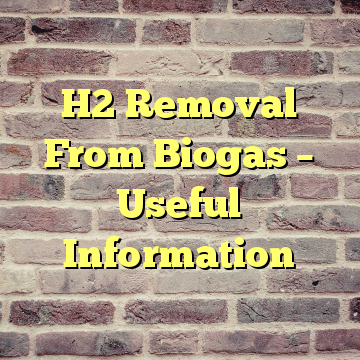It is known fact that there are trace quantities of hydrogen sulfide or H2 in biogas and it has to be removed. This is because it is harmful and could also be poisonous for health. Further, it also has a corrosive property that could damage the various mediums that are used to transport it. Hence, there is an important need to remove hydrogen sulfide from gas. This process is often referred to as desulfurization. There are a few ways and methods that can be used for removing it. As is the case with carbon dioxide, water scrubbing and caustic scrubbing are the methods that are generally used to remove H2 from biogas. We will learn more about it over the next few lines.
What Is Water Scrubbing
This is a commonly used and proven method for removing hydrogen sulfide from biogas. In this method, gas is passed through water. Water has the capacity of absorbing a part of the hydrogen sulfide removal. But according to some experts, this process may not be the best way forward for removing H2. It does work very well for CO2 removal. This is perhaps because of a few reasons. Low partial pressure is an inherent property of H2. This often results in low mole friction absorption as far as hydrogen sulfide in water is concerned. Hence, this could be one of the main problems of water scrubbing for removal of H2 or hydrogen sulfide from biogas.
Caustic Scrubbing
This is another effective method for removal of h2s from gas. It works on the principle that when a caustic solution reacts with CO2 gas streams, this results in many changes. It leads to a reversible carbonate forming a reaction that is followed by another change. It leads to the formation of a reaction that has its origins from irreversible potassium hydrosulfide. When this happens, it appears as a yellow precipitate.
There are reasons to believe that it is possible to remove hydrogen sulfide and also carbon dioxide with the use of other chemicals such as trisodium phosphate, ammonical solutions, sodium phenolate, and various other alkacid processes. However, they are not without their own share of problems and limitations. The costs of purification are quite high because in caustic scrubbing it is common to see hydroxides such as calcium, sodium, and potassium being used in the entire purification process.
Solid Chemical Absorption
This is a simple and practical method that is commonly used for the desulfurization of biogas. It is considered quite efficient for situations where there is no need for removal of other impurities. This method is about using or iron sponge. This is nothing but a combination of wood shavings and ferric oxide that are kept in a dry scrubber. When the reaction takes place, the gas also is purified.
The good thing about this method is that it is not very expensive and it is also easy to operate and maintain. Zinc oxide, in place of ferric oxide, can also be used for desulfurization. It comes with the added advantage of being in a position to remove organic sulfur compounds and these include mercaptans and carbonyl sulfide.
Contact US:
Phone: (800) 624-4356
